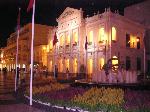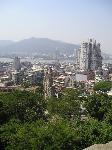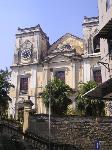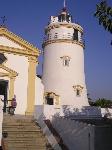- Getting around Lijiang. Dont stay in the Old Towns more than 2 days, there is nothing to do. KRISS Oct 9, 2013 05:46
- 2013 Beijing Temple Fair BENNYLAU Feb 26, 2013 03:29
- Malaysian traveling from KUL - LAX vis Shanghai PVG ZATI_DY Jan 3, 2013 20:15
In the wake of Ancient Mariners
- Views: 6157
- |Vote: 0 0
- |Add to Favorites
- |Recommend to Friends
I’ve always had a deep respect for men of the sea for in their wake go others - merchants, scoundrels, missionaries, scholars, mothers, entrepreneurs and more. Such was the case of Macau which for centuries had offered safe haven for both refugees and mariners. During the 12th and 13th centuries, members of the Song Dynasty court fleeing the Mongol invasions found refuge here, establishing and defending the first significant settlements. The first commercial interests came from the Hokla boat people who developed Macau as a trading centre for the southern provinces. But it was the Portuguese traders however who finally established Macau as an international staging port - a safe haven on the long voyage from Lisbon to Nagasaki in Japan.
The Portuguese mariner Jorge Alvares was the first to arrive in 1513 and as Macau prospered it was inevitable that a formal trading agreement was signed in the 1550’s making Macau the oldest permanent European settlement in the Far East. In this agreement Portugal promised to rid the area of pirates and pay an annual tribute to China. This agreement lasted almost 300 hundred years until 1849 when Portugal declared Macau a free port which was confirmed by China in the ‘Protocol of Lisbon’ in 1887. Being strategically located midway on the lucrative trading route between India and Japan, Macau soon prospered. Enterprising Chinese merchants unable to go abroad themselves hired Portuguese agents to act on their behalves. It was not long before traders from many other countries sailed into port.
After the British took possession of Hong Kong in 1841 during the Opium wars, Macau’s fortunes languished. Now a sluggish backwater Macau became a haven for smugglers and gamblers. With the introduction of licensed gambling in 1850 her economic fortunes revived but she would remain largely in the shadow of a much more independent and garrulous Hong Kong. More recently Macau became a haven for many fleeing the Civil War and the Cultural Revolution on the mainland between 1949 the late 1960’s. Macau’s fortunes continue to soar as an ever increasing number of tourists flood this small but fascinating former colonial enclave. Like the ancient mariners before them, many come by ferry from Hong Kong.
A visit to Zhuhai during the Golden Week of October gave us the perfect opportunity to take a peek and we were pleasantly surprised to find that neither Zhuhai nor Macau were ‘hot’ destinations for Chinese mainlanders. Our first view had been from the waterfront of Zhuhai the day after our arrival and it looked much like any other part of China. Early one morning, a few days later we stood at the Portas de Cerco, the pedestrians Border Gate with Macau amidst the hundreds of thousands of people who make this journey daily, weekly or perhaps monthly or less. After first clearing China’s immigration who dallied slightly over our visas we took the short walk through ‘no man’s land’, before clearing Macau’s immigration and customs.
We finally emerged into another world. Bilingual signs were everywhere but we were none the wiser in understanding – most were in Portuguese and Chinese characters. Our limited Mandarin fell on many deaf ears since the ‘lingua franca’ of Macau is Cantonese and Portuguese – although Mandarin and English are widely spoken in the business, banking and tourism sectors. Our first goal was to find a bank and change some money into the local currency, the pataca which is roughly the same value as the RMB. This proved a little harder than expected but we took advantage of the search to sightsee as there was something interesting around every street corner. These were narrow and noisy, sidewalks cluttered with goods for import or export, multitudes of motor scooters and people doing business.
Macau is compact. One of the most densely populated places on earth, it consists of a small peninsular – her commercial hub – and the two islands of Taipa and Colôane. With both a safe inner and outer harbour, sheltered from the south by the islands it was an ideal choice for the early seafarers and today it is still a functional and picturesque port. Taipa is connected to Macau city and the mainland by bridges; Taipa and Colôane islands are connected by a causeway. Land reclamation has increased its area enabling the construction of the airport on Taipa which was opened in 1995 and the expansion of her commercial centre. Public transport is convenient and easy and not too crowded but you need a little pataca to pay your way. It’s a good idea to change a little before arriving depending on how and where you come in.
Armed with some local currency we jumped on one of the compact public buses endeavouring to make our way to the Senate Square. This first bus terminated in a small shady plaza surrounded by the Cameos Grotto and Gardens, St Anthony’s church and the Morrrison Chapel with an old Protestant cemetery in the grounds. The chapel is named in commemoration of Robert Morrison, the first Protestant missionary to China who is buried here. As with most colonial exploration and settlement missionaries soon followed the mariners and merchants and Macau has an interesting and eclectic assortment of churches and cemeteries.
For me, reading headstones is like reading from the pages of a history book. A stroll around the old cemetery revealed a glimpse, however small into the lives of a colourful mix of characters who must have arrived full of hopes and fears and dreams – but who would never leave her shores. Their headstones give a brief but all too graphic account of long-lived fruitful lives in contrast to others cut short by misfortune, mishap or measles. Little known merchants and mariners, ministers and mothers, minors and missionaries, now rest in peace beside a few more well known names like Irish born artist George Chinnery and Lord Churchill (an uncle of Winston Churchill’s). Macau’s colonial history of more than 400 years is a rich tapestry written together with the lives of both ordinary and extraordinary people from many different nations.
We continued walking, still heading for the Senate Square. Narrow cobbled streets twisted away in several directions and the one we followed led down to the waterfront on Rua des Lorchas. These once noisy and bustling docks are quiet now, just a shadow of the prosperous days of long ago. The harbour front is lined with decayed and shabby shops, warehouses and old hotels on the street opposite. We turn left into Avenida de Almeida Riberio, lined with covered porticos above prosperous shopfronts - windows displaying gold, silver and jade jewellery, tea and traditional Chinese handicrafts - and eventually arrive in the commercial and business district surrounding Senate Square. The square is paved in black and white stripes - large and irregular - like the waves of the sea. A fountain dominates the centre. Surrounding it on three sides are stately pastel painted buildings, on the forth a narrow busy thoroughfare.
The best way to see the sights is walking and the best place to begin is from the Largo de Senado or Senate Square. Since 1992 many of the historical colonial buildings of any significance have been restored. Walking tour maps are available from the tourist office on the western side of the square just along from Starbucks. Brand name boutiques and shops selling ‘knock off’ clothing and accessories surround the square and fill the narrow side streets. Quaint restaurants and coffee shops line the streets as they wind their way out of the square. The first building of historic interest outside the square would be the 17th century baroque Church of St Dominic’s said to be the most beautiful of all and located a short distance from the Square on the walking route to St Paul’s and the Monte Forte.
Arguably one of the most famous sights of Macau is the ruins of the Church of St Paul. The church, built for the Jesuit missionaries in 1602 by Japanese refugees from Nagasaki was destroyed by fire in 1885. It began in the kitchen during a period that the church was being used as military barracks after the expulsion of the Jesuits in 1762. All that remains today is the façade, a staircase and the mosaic floor. Nearby is the crypt containing the tomb of Alessandro Valignano, who is believed to have taken Christianity to Japan. Between 1617 and 1626 the Jesuits also built the fort on the hill overlooking the church. The canons of Monte Forte, fired only once to repel an attempt by the Dutch in 1622 to take Macau, now have the cities high rise buildings squarely in their sights.
Monte Forte houses the Macau Museum with displays of the history, culture and traditions. A five day museum pass is available for the Maritime Museum, Grand Prix Museum, Wine Museum, Macau Museum of Art and the Museum of Macau. The view from here as you walk around its shady ramparts is one of the best.
Another popular walking tour takes in several of the former colony’s churches including St Augustine’s built in 1814, the Dom Pedro V Theatre across the street, St Lawrence’s Church originally built of wood in 1560 and later reconstructed in stone, and the former government House. St Michael’s church which can be seen from the Forte stands surrounded by another much larger cemetery next to the 400 year old Kun lam Temple which is dedicated to the Goddess of Mercy. Macau takes its name from A-Ma-Gau harbour, which in turn is named after none other than A-Ma, the goddess of seafarers. A Temple dedicated to her is situated north of Barra Hill near the tip of the peninsular and the boat people of Macau come here each year in April and May to pay homage to her.
The Guia Fort and the lighthouse reserve, the highest point on Macau peninsular, overlooking the outer harbour, gives a commanding 360º view of Macau and the mainland. Ferries to and from Hong Kong depart from the outer harbour below, slipping beneath the graceful Ponte de Amizade which connects Taipa with the peninsular. Stark white as spray, trimmed in sun gold, against a brilliant backdrop of blue this 15m high lighthouse was first lit in 1865. Not only is it the oldest lighthouse on the China coast it is one of the smallest and by far the prettiest I have ever seen. A small chapel keeps silent company by its side.
While the lighthouse no longer guides sailors into port it does remain a silent reminder of these intrepid seamen as it overlooks this melting pot of East and West. Today, Macau’s rich and diverse history, culture and religions attract far more than mariners, merchants and missionaries from all around the world.
For more on Macau please read my travel review
'Monte Carlo of the Orient'
and view my photo album










 Copyright © 1998-2025 All rights reserved.
Copyright © 1998-2025 All rights reserved.